The basics of Peak Oil
Peak oil is the moment in time when global supply reaches an all time high and goes into decline. It doesn’t mean we are going to run out of oil but it does mean that supply will no longer keep pace with demand leading to much higher prices and periodic scarcity. This geological reality will have a dramatic impact on the global economy, which is totally dependent on cheap and abundant oil supply, not only for transportation, but also for food production and many of the things we take for granted each day.

Fossil fuels are finite and non-renewable. It is a geological certainty that they will eventually run out. In the case of liquid fuels, namely crude oil, we are reaching a peak in production.
The world was endowed with approximately 2 trillion barrels of conventional oil and we have already consumed about 1/2. If you were born during the 60s and live for 70 years then during your lifespan over half of the worlds oil supply, which formed over millions of years of geological time, will have been consumed!
In the long time span of human history the oil era will be a short blip of little over 200 years. Not only that but Gas, coal, uranium – all these fuels are finite resources and each one will eventually peak. Peak oil is simply the first.
Oil is our primary energy source

Fossil fuels are our primary energy source and account for 80% of the global energy supply. In Ireland 97% of our energy is fossil fuel based and 92% is imported.
Wind, solar, tidal and geothermal will grow explosively over the coming years but they are starting from a very small base representing barely 1% of the total.
Even with a major international program, similar to during the 2nd world war when car factories were turned over to making artillery, it is difficult to see how the coming shortfall will be offset.
Hubbert’s Peak
The amount of oil you can produce can only ever equal the amount of recoverable oil you discover. The area under both curves must eventually be equal.
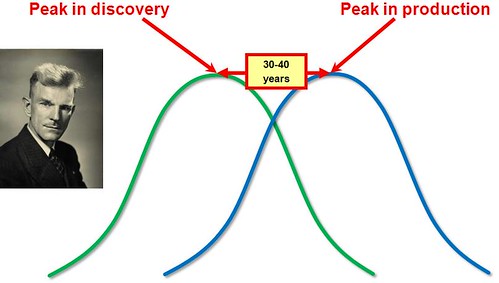
A geologist working for Shell in the 30’s called M. Hubbert noticed how production in an oil region would follow a distinct bell shaped curve. As individual wells came online production would rise rapidly to a peak. As the pressure in the wells dropped, production would then decline, eventually become uneconomic and cease.
Historically the length of time between a peak in oil discovery and a peak in oil production has been 30-40 years.
Having noticed that oil discoveries in America had peaked in the early 30’s Hubbert forecast a peak in US oil production for 1970. He was correct.
US Oil Production
Skeptics often call peak oil a theory but in actual fact it is something that has been observed to happen in many oil producing countries around the world.
The history of US oil production is a case study in oil depletion. Whilst not exactly a bell shaped curve the peak of production occurred in 1970 followed by two lower peaks when the Alaskan and Gulf of Mexico fields came on line.

Overall US oil production has been in decline since the early 70’s and they are now ½ way down their domestic production slope and import 2/3 of their oil needs.
UK Oil Production
The history of oil production in the UK shows a production peak in the late 1990s.
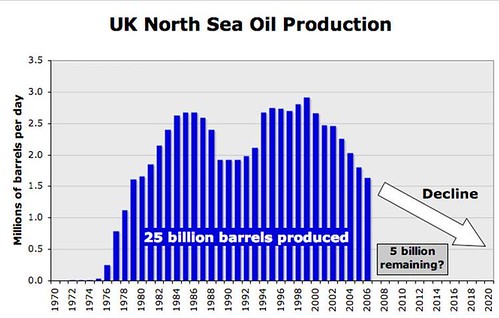
The UK Dept of transport admits that production of the North Sea oil and gas fields peaked in 1990, is now in decline and will be exhausted by 2020.
Global Oil Production
The blue bars represent all the oil discoveries to date and the black line represents production.
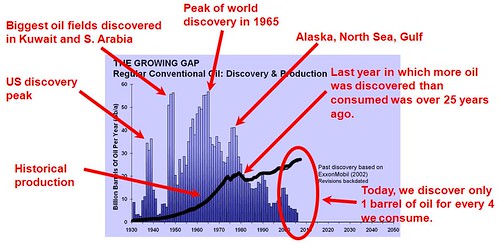
#1 Discovery of US oil peaked in the late 30’s.
#2 The biggest oil fields in the world in Kuwait and S. Arabia were discovered in the late 40’s more than half a century ago.
#3 World oil discovery peaked in 1965
#4 Alaska, the North Sea and the oil fields of the Gulf were discovered in the mid 70’s
#5 The last year in which we discovered the same amount of oil that we consumed was over 25 years ago.
#6 Since then consumption has continued to climb and discoveries have continued to fall. Today we discover only 1 barrel of oil for every 4 we consume. This is completely unsustainable.
Oil producing countries past peak
Many oil producing countries are well past peak production with an average decline rate of 3%. Some countries, such as Mexico, are plummeting at over 5% per year.
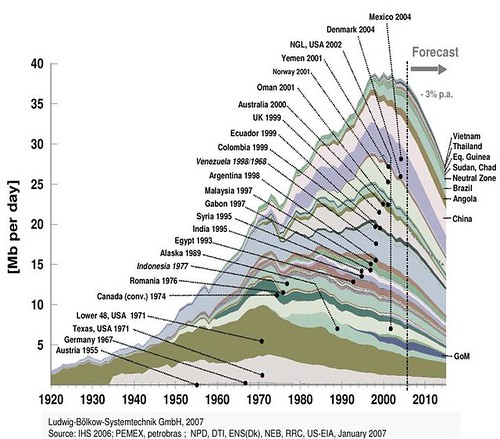
Of the 98 oil producing countries in the world 68 have already passed peak production. On the map, red countries have peaked, green countries have not.
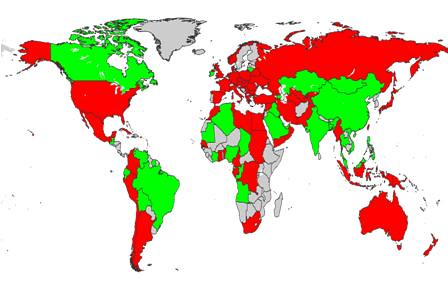
When global peak occurs (2010-2012) the decline rate is expected to be 2.5% per year. This does not sound like much until you realise that in 20 years we will have half of the oil available compared to what we have today.
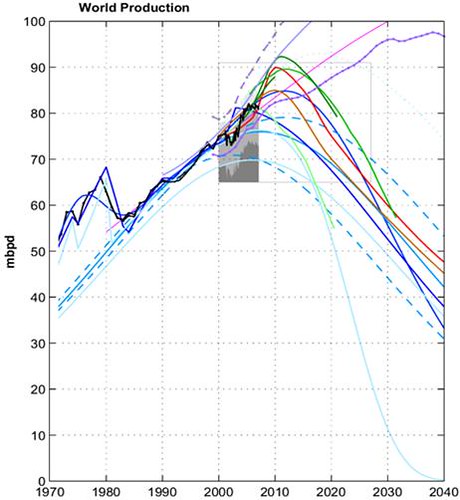 When will we peak?
When will we peak?
The argument is when will we peak, not if we will peak .
The graph opposite shows various predictions of the global oil peak. They cluster around 2010, with a few optimistic analysts, predicting a peak many years in the future.
The predictions are from government bodies like the International Energy Agency, oil companies like BP, the Association for the Study of Peak Oil and independent researchers like Chris Skrebowski.
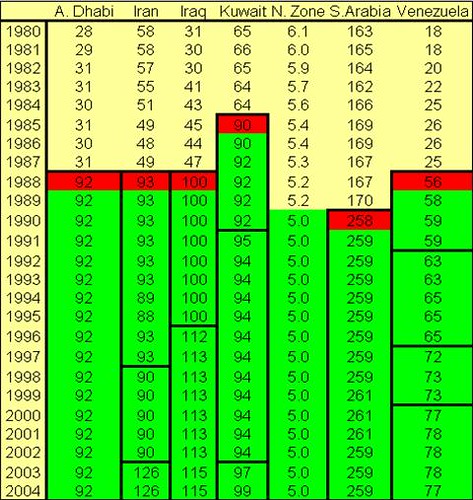 Why the uncertainty?
Why the uncertainty?
70% of the world’s remaining oil reserves lie in just 5 middle east countries. The reason for the uncertainty over the date is because of unreliable data over the amount of OPEC oil reserves:
#1 In the late 80’s reserve estimates for these countries jumped overnight by as much as 100% without any new discoveries being announced.
#2 Since then reserve figures have remained flat implying that each year each country discovers exactly the same amount of oil that it produced.
This uncertainty gives rise to various estimates for a global peak varying from now until 2025. As time goes by forecasters are narrowing in on 2010-2012.
Peak Oil is happening now – if you are poor
 Many developing countries above are experiencing severe problems with energy supply which in turn is causing food prices to soar. For the moment we are insulated from the effects peak oil since we can afford the high oil prices. Perversely as poorer countries are effectively pushed out of the market for oil, more is available for richer countries.
Many developing countries above are experiencing severe problems with energy supply which in turn is causing food prices to soar. For the moment we are insulated from the effects peak oil since we can afford the high oil prices. Perversely as poorer countries are effectively pushed out of the market for oil, more is available for richer countries.
Impacts of Peak Oil
 Unlike climate change there has been very little work done on forecasting the effects of peak oil. One study carried out by the City of Portland assessed the range of possible impacts of peak oil on the city and drew three possible scenarios. They are presented in decreasing order of desirability.
Unlike climate change there has been very little work done on forecasting the effects of peak oil. One study carried out by the City of Portland assessed the range of possible impacts of peak oil on the city and drew three possible scenarios. They are presented in decreasing order of desirability.
#1 Long-term transition
A gradual decline in resources will allow sufficient time for mitigation options to be put in place. Voluntary reduction in oil consumption of 2.5% per year in line with the expected depletion rate. 50% less oil available in 20 years time.
#2 Oil Shocks
Without any mitigation efforts and a slow decline in oil supply society will lurch from crisis to crisis as supply disruptions and price hikes take hold.
#3 Disintegration
Without any mitigation efforts and a sudden decline in oil supply the impacts of peak oil will become so severe that the fabric of society will begin to unravel.
The top 3 recommendations of the report were:
- Reduced total oil and natural gas consumption by 50% over the next 25 years
- Inform citizens about peak oil and foster community and community-based solutions
- Engage business, government and community leaders to initiate planning and policy change.
